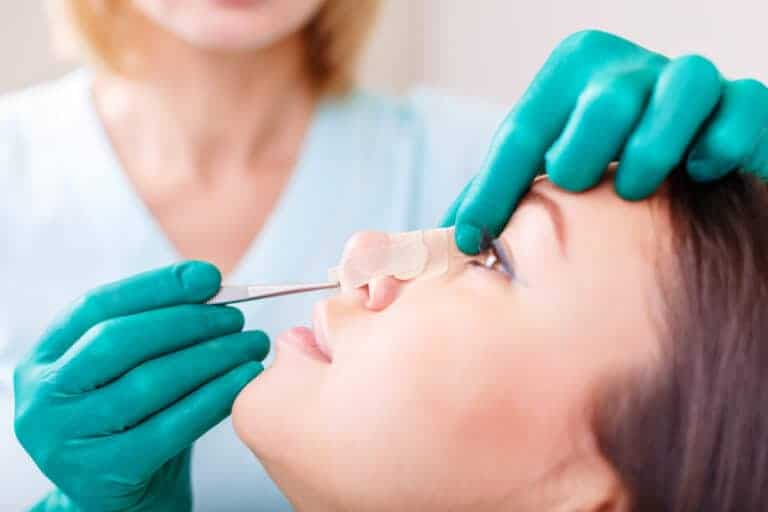Rejuvenate Your Look with a Facelift and Necklift: What Signs of Ageing Can It Correct?
As we age, our skin begins to show signs of wear and tear. These include wrinkles, sagging skin, and the formation of jowls. Facelift surgery is one of the most popular treatments for reversing the signs of ageing. However, it is an invasive procedure with potential side effects and a lengthy recovery period. An alternative option is a non-surgical facelift, which offers many of the same benefits as traditional surgery without the risks. This article will provide an overview of the signs of ageing, explain what a non-surgical facelift is, and outline its benefits and drawbacks. Additionally, it will discuss maintenance top-up treatments that can help prolong the results of a non-surgical facelift.
Non-surgical facelift offers same benefits as traditional surgery without risks, with top-up treatments to prolong results.
Signs of Ageing
Ageing is an inevitable process that affects everyone. As we age, our skin begins to sag and wrinkle, leading to a diminished appearance. Fortunately, there are various treatments available to reduce the signs of ageing and restore a youthful look.
Lower Angle of Insertion
The lower angle of insertion is the point where the facial muscles connect with the bone structure in the face. As we age, this angle decreases due to decreased muscle tone and sagging skin. This can lead to a droopy, tired-looking appearance.
Facelift Surgery
Facelift surgery is one option for reducing the signs of ageing. This procedure involves tightening the underlying facial muscles and removing excess skin from around the neck and jawline. Facelift surgery can provide dramatic results but may require significant downtime and recovery time.
Submental Fat
Submental fat is another common sign of ageing. As we age, fat accumulates beneath the chin, creating a double chin or “turkey neck” appearance. This can be addressed through liposuction or other minimally invasive treatments such as Kybella injections or CoolSculpting.
Neck Muscles
As we age, our neck muscles weaken and become less elastic, resulting in sagging skin on the neck area known as “turkey neck”. Neck lifts can help to improve this area by lifting and tightening these muscles for a more youthful appearance.
Jowls Formation
Jowls form when excess fat accumulates along the jawline due to aging or weight gain. This can create a droopy, saggy appearance that many people would like to address. Fortunately, there are various non-surgical treatments available that can help reduce jowls and restore a more youthful look.
Lower Angle of Insertion
The lower angle of insertion is the point where the skin and muscles on the lower face meet, usually around the jawline. This area often begins to sag with age as collagen and elastin production decreases, resulting in a less defined jawline. Ageing can also cause fat deposits to accumulate in this area, further contributing to sagging. The loss of skin elasticity in this area can make it difficult for people to maintain a youthful appearance without surgical intervention.
Facelift Surgery
facelift surgery, also known as rhytidectomy, is a surgical procedure that helps to reduce the signs of aging by tightening the skin and underlying muscles of the face and neck. It is typically performed on those who have sagging skin around the cheeks, jowls, and neck due to age or weight loss. During a facelift surgery, an incision will be made along the hairline from ear to ear, and excess skin will be removed. The remaining skin will then be tightened and repositioned for a more youthful appearance. In some cases, fat may be removed from the area to create a smoother contour. The surgeon may also tighten or reposition the facial muscles depending on the patient’s needs.
In addition to removing excess skin, a facelift can help reduce wrinkles and fine lines in the forehead, cheeks, chin, and neck areas. This procedure can also improve the appearance of sagging jowls or drooping eyebrows. However, it cannot completely eliminate deep wrinkles or correct severe sun damage.
The results of a facelift are usually long-lasting; however, they may not be permanent depending on how quickly your body ages after treatment. It is important to maintain healthy lifestyle habits such as eating nutritious foods and exercising regularly following your facelift in order to extend its effects for as long as possible.
Facelift surgery can reduce signs of aging, remove excess skin, reduce wrinkles and fine lines, and improve sagging jowls or drooping eyebrows. Results can be long-lasting, but require healthy lifestyle habits to maintain.
Submental Fat
Submental fat, also known as a double chin, is one of the most common signs of ageing. It is caused by an accumulation of fat under the chin and can be exacerbated by genetics, weight gain or age-related changes in skin elasticity. A submental fat reduction procedure can help to reduce the appearance of a double chin, giving a more youthful look to the face.
Causes
Submental fat can be caused by several factors including genetics, weight gain, and lifestyle choices such as smoking. It can also be related to age-related changes in skin elasticity which cause it to become less firm and stretch out more easily. In some cases, it may occur due to hormonal imbalances or medical conditions such as hypothyroidism.
Treatments
There are several treatments available for reducing submental fat including liposuction, facial exercises, and non-surgical options such as Kybella injections and CoolSculpting. These treatments all work to break down the fat cells under the chin and reduce their volume over time. Depending on the severity of the condition, multiple sessions may be necessary for optimal results.
Neck Muscles
The neck muscles, also known as platysma, are a broad sheet of muscle which are located in the neck and extend from the lower jawbone to the collarbone. These muscles help to support the chin and neck area, and can be weakened with age due to natural sagging or laxity. The platysma can be strengthened through facial exercises such as chin tucks, neck rolls, and other strengthening techniques. Additionally, certain cosmetic procedures such as Botox injections can be used to reduce the appearance of wrinkles in this area.
Jowls Formation
Jowls are the sagging skin at the sides of the jawline and chin that can form as a result of ageing. They are caused by a combination of factors such as loss of collagen, elastin, fat and muscle tone.
Causes
The main cause of jowls is the breakdown of collagen and elastin in the skin which leads to sagging. This can be accelerated by smoking, sun exposure and poor nutrition. As we age, our facial muscles weaken and lose their tone which causes our skin to droop down, leading to jowl formation. Additionally, fat deposits in the lower face tend to accumulate over time which can worsen the appearance of jowls.
Treatment
The most effective treatment for jowls is a surgical facelift which involves tightening the underlying muscle structures and removing excess skin from around the jawline. Non-surgical treatments such as dermal fillers or radiofrequency technology can also be used to help reduce jowls but they are not as effective as surgery. For those looking for a more natural approach, lifestyle changes such as quitting smoking, eating healthily and avoiding too much sun exposure may help slow down the formation of jowls.
Non-Surgical Facelift
Non-surgical facelifts are a popular alternative to surgical facelifts. Non-surgical facelifts use injectables, such as Botox and dermal fillers, to reduce the signs of aging on the face and neck. The procedure is typically done in a doctor’s office and can be completed in less than an hour with minimal downtime.
Benefits of Non-Surgical Facelift
The primary benefit of a non-surgical facelift is that it does not require any incisions or general anesthesia. This means that there is no risk of infection or scarring associated with the procedure. Additionally, non-surgical facelifts are much less expensive than traditional facelifts and can be completed in a matter of minutes. The results of a non-surgical facelift will last anywhere from six months to two years depending on the type of injectable used and how quickly your body metabolizes it.
Non-surgical facelifts can also be used to address specific areas of concern, such as wrinkles around the eyes or lips, sagging skin on the cheeks or jawline, and volume loss in certain areas of the face. By targeting these specific areas with injectables, you can achieve a more natural looking result without having to undergo surgery.
Drawbacks of Non-Surgical Facelift
The main drawback of a non-surgical facelift is that it cannot address more severe signs of aging, such as deep wrinkles or sagging skin caused by excess fat deposits under the chin or jowls. Additionally, results may not last as long as those achieved with a traditional facelift. Finally, some people may experience temporary bruising or swelling at the injection site following treatment.
Maintenance Top-Up Treatments
In order to maintain your results for longer periods of time, you may need to have maintenance treatments every 6 months to 1 year depending on how quickly your body metabolizes the injectables used during your initial treatment session. During these follow up visits your doctor will assess your skin’s condition and determine if additional treatments are necessary in order to keep your skin looking its best.
Overall, non-surgical facelifts provide an effective option for those who want to reduce signs of aging without undergoing surgery. While they cannot address more severe signs of aging like traditional facelifts can, they do offer an affordable way to improve overall facial appearance with minimal downtime and risk involved.
Benefits of Non-Surgical Facelift
Non-surgical facelifts are becoming increasingly popular as a way to reduce signs of aging without the need for surgery. There are many benefits to this type of treatment, including:
Cost
Non-surgical facelifts are usually much less expensive than traditional surgical facelifts. This is due to the fact that there is no hospital stay, and no need for anesthesiology or other medical personnel. Additionally, non-surgical treatments can often be done in the comfort of your own home, allowing you to save even more money on travel and lodging costs.
Safety
Non-surgical facelifts are generally considered to be very safe procedures with minimal risks or side effects. The treatments are noninvasive and typically involve the use of topical creams or gels that contain natural ingredients which have been proven to be effective at reducing signs of aging.
Convenience
Another benefit of non-surgical facelifts is the convenience they offer. Since they do not require an operating room or recovery time, they can be completed quickly and easily in the comfort of your own home. Additionally, non-surgical treatments can often be done in just one session, which means you don’t have to take time off from work or other obligations to get them done.
Results
Finally, non-surgical facelifts can produce impressive results when it comes to reducing signs of aging. These treatments can help improve skin tone and texture, reduce wrinkles and fine lines, and give you a more youthful appearance overall. The results may not last as long as those achieved with surgical procedures, but they can still provide a noticeable improvement in your appearance without the need for surgery or downtime.





